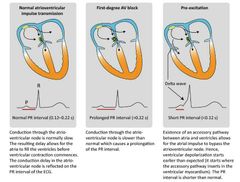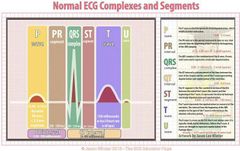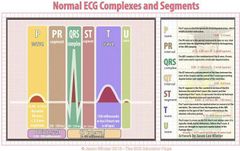![]()
![]()
![]()
Use LEFT and RIGHT arrow keys to navigate between flashcards;
Use UP and DOWN arrow keys to flip the card;
H to show hint;
A reads text to speech;
29 Cards in this Set
- Front
- Back
|
Left anterior descending artery (anterior interventricular a.) supplies: |
2/3 of anterior interventeicular septum. portions of left ventricle. |
|
|
Posterior interventricular a. supplies: |
1/3 of interventricular septum. |
|
|
T or F: Left anterior descending a. (anterior interventricular a.) is also known as widow maker artery because coronary occlusion occurs there often. |
T |
|
|
Ischemia Myocardial ischemia |
a restriction in blood supply to tissues, causing a shortage of oxygen that is needed for metabolism. Generally, caused by problems with blood vessels, with resultabt damage to or dysfunction of tissue. Myocardial ischemia: restriction of blood supply to heart muscle. |
|
|
Angina. Angina pectoris. |
A type of heart pain caused by reduced blood flow to the heart. Can be a symptom of coronary artery disease. |
|
|
Coronary artery disease (CAD) |
involves the reduction of blood flow to the heart muscle due to build up of plaque in the arteries of the heart. Types: stable angina unstable angina myocardial infraction sudden cardiac death |
|
|
Coronary occlusion |
the partial or complete obstruction of blood flow in a coronary artery. This condition may cause a heart attack (myocardial infraction). May damage the myocardium. |
|
|
ST segment elevation |
ST segment: ventricular plateau phase. When a person has a heart attack (myocardial infraction), this segment will no longer be flat but will appear abnormally elevated. |
|
|
ST segment depression |
A sign of myocardial ischemia, of which coronary insufficiency is a major cause. The thrombi (blood clots) may dislodge and may travel anywhere in circulatory system, where they may lead to pulmonary embolus, an acute arterial occlusion causing the oxygen and blood supply distal to the embolus to decrease supplym |
|
|
T or F: without AV nodr delay, the heart rate would be very high meaning a lot of contractions. |
T |
|
|
T or F: contractile cells are within the ventricles. They are the one's that contract the ventricles. |
T |
|
|
Synchronisation of contractions |
Gap junctions, intercaletated discs (communication). Desmosomes (structural support) |
|
|
Action Potential: pacemaker and contractile cells. |

Pacemaker cell: Action potential:
Slowler initial depolarization because cells lack voltage gated Na+ channels. Instead, they have HCN channels (funny channels).
Full depolarization phase: Ca2+ channels OPEN at threshhold. Repolarization phase: Ca2+ channel CLOSE. Minimum potential phase: K+ channel remain open. Membrane hyperpolarizes. This opens the HCN channels and cycle continues.
Starting membrane potential: -60mV. Threshold membrane potential: -40mV. Voltage gated Ca2+ channels open, and Ca2+ enter the cell, causing the membrane to fully depolarize. Fully depolarized membrane potential: +10mV.
**Lack plateau phase.**
Contractile cell: Action potential: Starting membrane potential: -85mV. Highest depolarization membrane potential: +20mV. Plateau phase membrane potential: 0mV
Rapid depolarization phase. Voltage gated Na+ channels ACTIVE.
Initial repolarozation phase: Na+ channels are INACTIVE. K+ leaks out.
Plateau Phase: Ca2+ channels open. Ca2+ enters as K+ exit, prolonging the depolarization.
Repolarozation: Na+ and Ca2+ close. K+ leaks out.
|
|
|
Intrinsic rate of depolarization |
60-80 times/min rate is subject to sympathetic and parasympathetic influence. |
|
|
Av node delay |
.13 sec. Allows ventricles to fill before they contract. |
|
|
Plateau phase (only contractile cells) |
Prevents tetany (sustained contraction) in heart by lengthing refractory period (period in which excitable cells can't be stimulated to contract again). This allows ventricles to fill with blood. |
|
|
T or F: plateau phases increases strength of heart's contraction |
True |
|
|
PR interval |

Beginning of P way. Includes atrial depolarization and AV node delay.
Time interval from start of atrial activation (depolarization) to start of ventricular activation (depolarization). The PR interval reflects whether impulse conduction from atria to the ventricles is normal.
2-2.5 normal
2.75 or higher abnormal -may indicate a first degree heart block (hypokalemia) -Causes: AV valve issues, hypertension -Disease: congenital heart disease
|
|
|
PR Segment |

Refractory period at the end of P wave.
The PR segment is the flat lone between the end of P wave and the start of QRS complex. The PR segment reflects the time delay between atrial and ventricular activation.
Abnormal: -Cause: AV node pathology. Heart block. -diseases: depression: pericarditis or atrial infraction.
|
|
|
Differences between segments and intervals |
Segments=elevation or depression Intervals=duration The important factor in analyzing segments on the ECG is their change from the isoelectric line---that is, elevation or depression---whereas the important thing in analyzing intervals is their duration. |
|
|
How electrical impulse travels from the atria to the ventricle? |
Under normal circumstances the electrical impulse travels from the atria to the ventricle via the atrioventricular (AV) node. The electric impulse cannot travel dorectly from atrial myocardium to ventricular myocardium because the two are electrically isolated from each other by fibrous rings. In some people, there are accessory connections (pathways) between the atria and the ventricles. These are embryological remnants and they may be located anywhere between the atria and the ventricles. Accessory pathways enable the atrial impulse to bypass the AV mode and thereby the impulse delay in the AV node. |
|
|
ST Segment |

Plateau phase (contractile cells) of the action potential corresponds to the ST segment. ST segment is flat because membrane potential is unchanged during plateau phase. Because ischemia primarily affects myocardial repolarization, it will cause changes in ST-segment and T-wave.
Elevation: myocardial infraction Depression: myocardial ischemia or occlusion (lack of O2)
|
|
|
Acute coronary syndrome and myocardial infraction |
An acute coronary syndrime occurs when coronary blood flow is reduced suddenly and severly due to atherothrombosis. The myocardial muscle supplied by the occluded artery will immediately become eschemic. If blood flow is not restored rapidly, the ischemic area will undergo infraction (necrosis) which leads to irreversible cell death. |
|
|
Myocardial infraction (necrosis) |
Affects myocardial depolarization (dead myocardial cells do not depolarize) which affects the WRS complex. |
|
|
Inotropic agents |
Contractility |
|
|
Chronotropic agents |
electrical system (SA node). Heart rate. Positive: Increase cardiac output. NE, Ca2+. Negative: Decrease cardiac output Low temperature, parasympathetic (Acetylcholine) |
|
|
How contractility affects stroke volume? |
Goal is a more efficient contraction so more blood gets ejected from the ventricle. Decreased ESV (remaining blood volume after ventricular contraction). Increases Stroke Volume. |
|
|
How afterload (resistance) affects stroke volume? |
Afterload= blood pressure in pulmonary and systemic circuits. Increased Afterload, Increases ESV which decreases stroke volume. |
|
|
What factors affect preload? |
1. Length of time ventricles spend in diastole. Refractory period gives time for enough filling so End Diastolic Volume increases. Refractory period gives time for enough filling so End Diastolic Volume increases.
2. Venous blood return |

